40 Actionable Email Marketing Tips That Will Boost Results
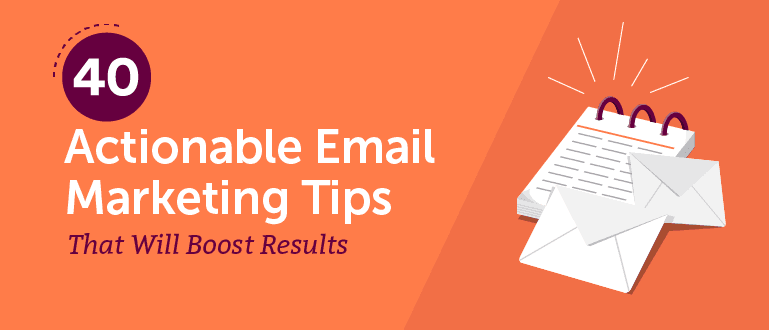 Email marketing is complex.
From list building to copywriting to measurement, there’s always something new to learn and improve.
For marketers and business owners with limited time, it can be difficult to keep up with.
This post covers 40 important email marketing tips, along with actionable advice to help you implement them right now.
Even if you’re an experienced email marketer, you’re sure to pick up at least a few new tactics.
Email marketing is complex.
From list building to copywriting to measurement, there’s always something new to learn and improve.
For marketers and business owners with limited time, it can be difficult to keep up with.
This post covers 40 important email marketing tips, along with actionable advice to help you implement them right now.
Even if you’re an experienced email marketer, you’re sure to pick up at least a few new tactics.
40 Actionable Email Marketing Tips That Will Boost Results via @CoSchedule
Click To Tweet10 Tips for Writing Better Email Subject Lines
Success starts with strong subject lines. According to Hiten Shah, “33% of email recipients open email based on the subject line alone.” You may have heard some variation of that figure before (different reports suggest a range between 30% to upper 40%). The key takeaway here is that paying attention to subject lines matters, and a little extra effort up front can boost the results of your entire email.1. Test Every Subject Line Before Delivery
Wouldn’t it be great if it were possible to test every subject line before you hit send? With the Email Subject Line Tester, there is. This free tool (which is also built into CoSchedule) makes it easy to optimize subject lines and see how they’ll look in recipient’s inboxes. Enter your subject line: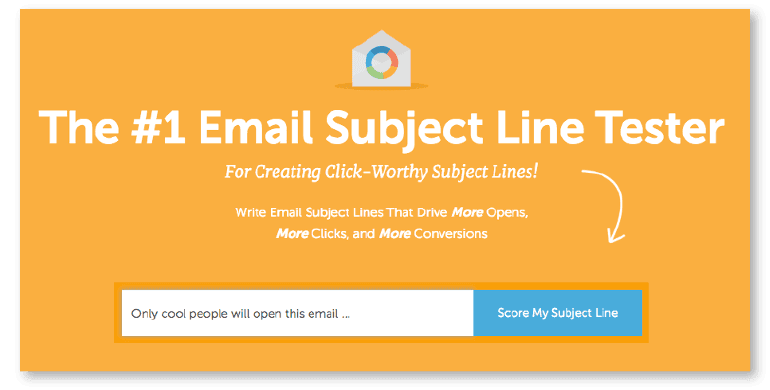 Then, get your score (and more):
Then, get your score (and more):
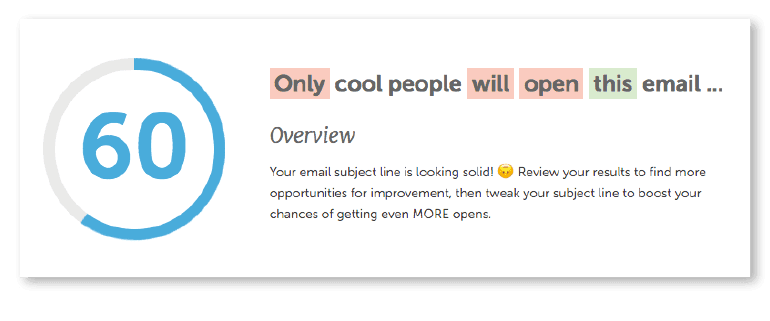 You can use it free as much as you’d like here.
You can use it free as much as you’d like here.
2. Use a Real Person’s Name in the Sender Field
Getting an email from an actual person feels more friendly than one from a brand. So, use an employee’s name in the sender field, rather than your brand name. For bloggers or solo consultants, your name might double as your brand. But, larger retail and B2B brands can benefit from this strategy, too. This example from Threadless shows how both can be combined: Most email service providers make it easy to edit the sender field. Consider using the name of the individual sending the email, or the best point of contact should a recipient have questions.
Most email service providers make it easy to edit the sender field. Consider using the name of the individual sending the email, or the best point of contact should a recipient have questions.
Sending marketing emails? Use a real employee's name in the sender field:
Click To Tweet3. Add Personalization
People want to feel like they’re more than just a number. So, to further make your emails more personable, include the recipient's name. Here’s an example of a plain-text email from Michael Hyatt using personalization:
Make email marketing more conversational with personalization
Click To Tweet4. Use Power Words
Subject lines should inspire readers to take action. So, include power words that motivate audiences to open and click. Use this cheat sheet: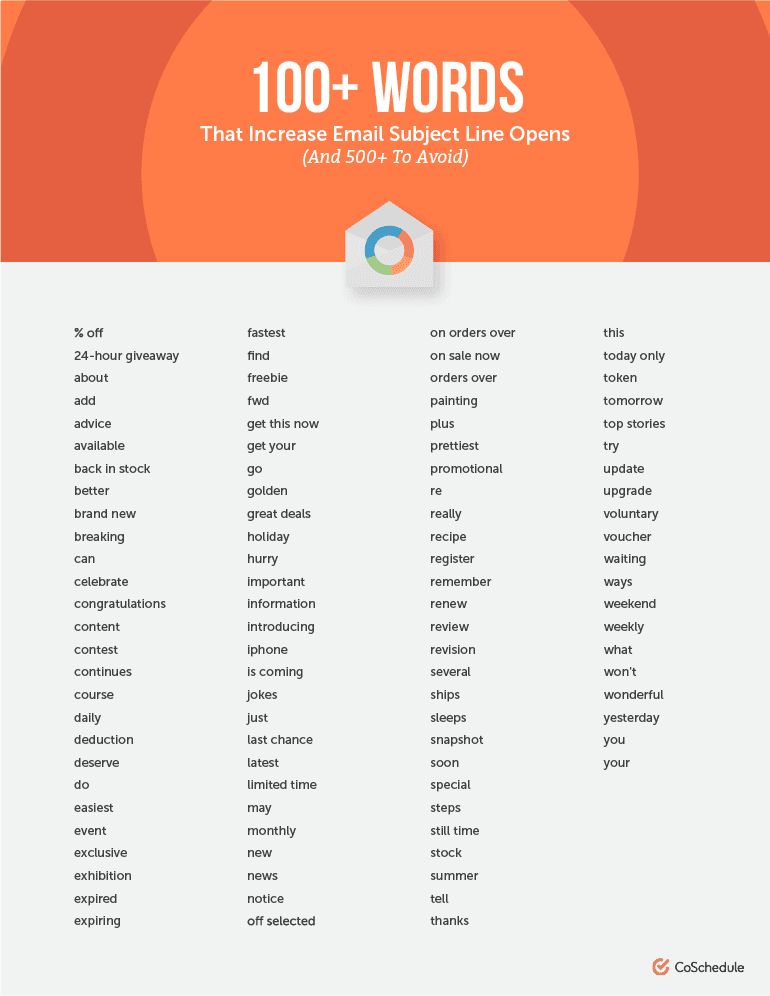
Use power words to increase #email open rates
Click To Tweet5. Experiment With Numbers and Stats
According to a study from YesWare, including a number (like an interesting stat or percentage) can influence a modest increase in clicks and replies: There are at least a couple reasons this might be the case:
There are at least a couple reasons this might be the case:
- Numbers are concrete. Subject lines that make vague promises are less compelling than those that state specific claims or benefits. For example, “Save 25%” is more useful than “Save Money.”
- Sometimes, stats are hard to believe (even if they’re accurate). And you just have to click for confirmation.
Experiment with numbers and stats in #email subject lines
Click To Tweet6. A/B Test Subject Lines
No study nor external data point will ever be as meaningful as your own results. One of the best ways to get insight into what works for your audience specifically is to A/B test as much as possible. Subject lines are one obvious email element to split test, and most email service providers make this easy. Here are some shortcuts to help documentation to get you started:Are you using A/B testing on your #email subject lines? If not, you might not be as successful as you could be.
Click To Tweet7. Create a Curiosity Gap
According to Wordstream, a curiosity gap is:The curiosity gap is a theory and practice popularized by Upworthy and similar sites that leverages the reader’s curiosity to make them click through from an irresistible headline to the actual content. By creating a curiosity gap, you're teasing your reader with a hint of what's to come, without giving all the answers away.How powerful can leveraging an informational gap be for copywriting? For Copyhackers, powerful enough to drive a 927% traffic increase to a pricing page. Imagine what it can do for your email marketing. To incorporate this technique into your subject line writing, do this:
- Identify the beginning and end of the story in your email.
- Leave out crucial information in the middle.
- “The easiest way to achieve your goal isn’t what you think.”
- “What’s the fastest way to achieve [GOAL]?”
- “Should you use this tactic to achieve [GOAL]”?
Create curiosity gaps in your email subject lines to get more opens.
Click To Tweet8. Make Use of Available Preview Text
Preview text appears in some email clients after the subject line. Usually, this space will be filled with copy from the email itself, if no preview text is specified. Leaving it blank is a missed opportunity, though, as it offers a chance to give your subject line more context. Here’s a great example from MarketingProfs: The subject line inspires urgency (“last call”), while the preview text offers more specifics (exactly how long the offer will remain, and how much can be saved).
This example from Stone Temple Consulting follows a similar principle:
The subject line inspires urgency (“last call”), while the preview text offers more specifics (exactly how long the offer will remain, and how much can be saved).
This example from Stone Temple Consulting follows a similar principle:
 Making use of preview text is simple: write your subject line, then add context. Here are some ideas:
Making use of preview text is simple: write your subject line, then add context. Here are some ideas:
- Tease an offer, then add more specifics.
- Include information about additional content in your email (that isn’t implied by the subject line itself).
- Ask a question in your subject line, and use the preview text to tease an answer.
Writing email subject lines? Don't forget to leverage space in the preview text field.
Click To Tweet9. Never Use All-Caps
Just don’t. It sounds like you're shouting in your reader's face.Avoid all-caps in email subject lines (and get 39 more email marketing tips here):
Click To Tweet10. Experiment With Emojis
Emojis are more than just fun illustrations. They can actually help improve opens on emails. In fact, according to Kim Courvoisier (formerly from Campaign Monitor), “brands that are using emojis have seen a 56% increase in their unique open rates.” Impressive. Will you achieve similar results? There’s only one way to find out: experiment! To quickly grab emojis you can copy and paste into your own emails, visit GetEmoji.com:
Could emojis help increase your email open rate?
Click To Tweet10 Email Copywriting Tips
Strong copywriting skills are essential for effective email marketing. Here are ten different ways to sharpen yours.11. Keep It Brief
Whether you’re writing subject lines or body copy, make everything as long as it needs to be, and no more. Here are some basic guidelines to follow:- Keep sentences under 25 words, and paragraphs under three sentences. These are considered basic best practices for web writing.
- Aim for 17-24 characters when writing subject lines. There’s no real “best subject line length,” but shorter copy is more likely to avoid getting cut off on mobile devices.
- Get to the point. Every word and sentence in your email should serve a clear purpose. If it doesn’t, then remove it.

Keep your #email marketing copy brief.
Click To Tweet12. Include One CTA (But Don’t Be Afraid to Include It In Multiple Locations)
Including a single call-to-action is a classic piece of email marketing advice. But, what about including that one CTA in multiple locations? This is a simple tip that can help increase clicks by placing a link at multiple spots where a reader is likely to be scanning across your copy: This email includes a CTA in each of the following places:
This email includes a CTA in each of the following places:
- Header graphic.
- Inline text.
- Conclusion CTA button.
Consider including one #email call-to-action in multiple places.
Click To Tweet13. Add a PS If You Need Extra Links
Newsletters and roundups, by their nature, include multiple links to various pieces of interesting content. But, if you’re writing a plain text email, it’s best to direct readers toward one location. For plain text emails though, if you have additional content to share, there is one place you can turn to: your PS section. "Check out this example from Sujan Patel, co-founder at Voila Norbert, which lists information about his upcoming speaking appearances: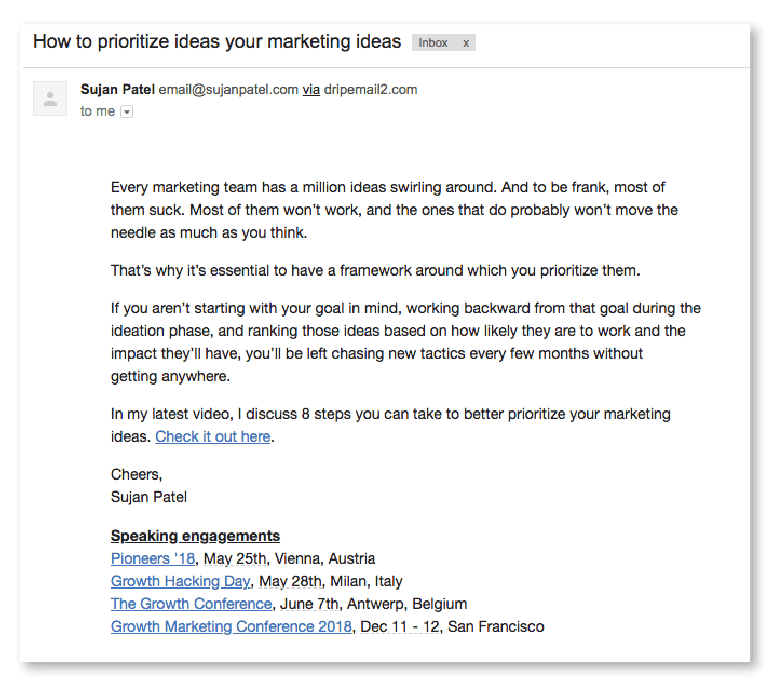 Some other things you could consider including might be:
Some other things you could consider including might be:
- Related articles or blog posts.
- Upcoming events.
- Recent company news announcements.
Get more email traffic by including additional links in a PS after your signature.
Click To Tweet14. Offer Something Valuable
Great copy won’t save a crappy offer. If what you’re selling isn’t worth your audience’s time, there’s nothing you can do to salvage success. Before sending an email, ask whether it passes the following criteria:- “Is the content or offer this is promoting high-quality?” This is obviously somewhat subjective, but if you’re sending email simply because you feel like you have to, it may be better to hold off.
- “Would I even want what I’m selling?” Put yourself in your readers shoes. If you read this email from another brand, would you even remotely care? Be honest.
- “Is there anything that could make this email more valuable?” An additional PS, a related piece of content, or something else?
Never send a marketing #email if you don't have anything valuable to offer.
Click To Tweet15. Always Put the Reader First
No one wants to listen to a brand talk exclusively about itself. Brands that solve problems for people, though? Those are the ones that get heard. When writing email copy, put the reader’s interest first:- Strong Example: “Cut your grass 35% faster with new, sharper mower blades.”
- Weak Example: “Our new mower blades are 35% sharper.”
Put your reader first when writing #email #marketing copy.
Click To Tweet16. Sell Benefits, Not Features
This is another classic piece of copywriting advice, and one that directly ties into the previous tip. Generally speaking, customers care more about benefits than features. A sharper mower blade isn’t important because it’s sharper; it’s better because it means the customer can spend less time mowing their lawn. Here’s an interesting example from MailChimp: Now, this could have been some superdry copy about GDPR. But, odds are, if GDPR means anything to you, you already know what’s up. So, it instead focuses on how MailChimp made creating GDPR-friendly forms easy enough to do in a few clicks.
Perfect.
Now, this could have been some superdry copy about GDPR. But, odds are, if GDPR means anything to you, you already know what’s up. So, it instead focuses on how MailChimp made creating GDPR-friendly forms easy enough to do in a few clicks.
Perfect.
Selling benefits, not features is #email #marketing #copywriting 101:
Click To Tweet17. Maintain Message Match Between Email + Landing Page Copy
You’ve sent out an awesome email. Your unsuspecting reader clicks, compelled by your copy, only to find the landing page doesn’t exactly sound like the email. Maybe the offer is different. Or, the theme of the copy isn’t quite aligned. Whatever the case may be, strive to maintain a consistent experience with your copy throughout the entire experience, from first click on a subject line, all the way through to a conversion on your landing page. Here’s a basic example of this done well, starting with a subject line from Adobe: Based on this text, one can assume the email will link to something with interesting photography from Tokyo. Once clicked, the headline on the body content makes it clear the reader is getting what they thought with this email:
Based on this text, one can assume the email will link to something with interesting photography from Tokyo. Once clicked, the headline on the body content makes it clear the reader is getting what they thought with this email:
 After clicking the button, the first thing you see is a blog header using the same banner image from the email:
After clicking the button, the first thing you see is a blog header using the same banner image from the email:
 The body copy in the blog post also follows through on the story the reader expected based on the initial subject line:
The body copy in the blog post also follows through on the story the reader expected based on the initial subject line:
 One consistent experience, from start to finish. That’s what marketers should always aim for.
One consistent experience, from start to finish. That’s what marketers should always aim for.
Make sure email copy matches the message on your destination landing page.
Click To Tweet18. Avoid Generic Templates
There’s nothing wrong with using a template as a starting point. But, everyone has seen the same plain text email templates, repeatedly. So, if you’ve seen something similar sent before, it’s time to go back to the drawing board, and come up with something fresh. That’s all there is to this tip. Say no to generic templates.Writing outreach emails? Say no to generic templates.
Click To Tweet19. Develop a Distinctive Voice
Everyone gets too much email in their inbox every day. To stand out, developing a distinctive brand voice is important. Create a brand voice chart similar to this one from Content Marketing Institute:
Write more engaging #email copy by developing a distinctive #brand voice:
Click To Tweet20. Make Copy Skimmable
Dense paragraphs of text typically perform poorly for email. So, keep sentences brief, and cut down paragraphs to a sentence or two (three at the max). Here’s an example from Siege Media that’s clear and easy to skim:
Don't make readers work! Make your #email #marketing copy skimmable instead.
Click To Tweet10 General Email Marketing Tips
Here’s a roundup of basic (but often overlooked) tips that, while small, add up to delivering a better experience for your subscribers.21. Make it Simple to Unsubscribe
Once you’ve got people on your list, you probably want to do everything you can to keep them there. So, why make it easy to unsubscribe? Because it creates a more positive experience. Someone might be interested in your brand, but just doesn’t want your emails anymore. If its tough to get off your list, that positive brand sentiment can quickly evaporate, to the extent they choose a competitor instead. This can be as simple as making the unsubscribe link clear and easy to find: In this example, the unsubscribe link is subtle and unobtrusive, yet easy to find for anyone looking for it.
In this example, the unsubscribe link is subtle and unobtrusive, yet easy to find for anyone looking for it.
Making email unsubscribes easy creates a more positive experience with your brand.
Click To Tweet22. Don’t Pay For Lists
There are lots of reasons you shouldn’t send emails to a paid list. Here are a handful:- None of those people will understand why they’re getting email from a company that may or may not have ever heard about.
- A lot of those people are liable to unsubscribe and they won’t convert anyway.
- Worse, you could violate the CAN-SPAM Act. This could be extremely bad news for your business.
Avoid paying for #email #marketing lists:
Click To Tweet23. Use Mobile-Friendly Design
Check out these mobile email stats from Campaign Monitor:- Emails that don’t render properly on mobile devices may get deleted in under three seconds.
- At least 50% of email opens happen on mobile devices (an exact number is tough to pin down, but that’s a lot).
- Mobile users check email 3X more frequently than desktop users.
- 52% are less likely to buy from a company if their mobile experience is poor.
Are your marketing #emails mobile-friendly?
Click To Tweet24. Add Alt-Text to Images and Buttons
Image alt-text helps tell web browsers and email clients more about the contents of an image. It’s useful for two reasons:- Helping the visually impaired understand what your images are.
- Providing context for images in case they can’t load.
25. Send Email at the Best Times for Most Opens and Clicks
The best time to send email will differ depending on your audience. But, there’s been plenty of research done to give us some solid starting points. Follow these guidelines:
Are you sending your #marketing #emails at the best times?
Click To Tweet26. Plan Your Email Schedule Around the Best Days to Send, Too
Start with a schedule that looks like this:
Here's how to pick the best days to send #marketing #email
Click To Tweet27. Manage Your Email Marketing Schedule on a Calendar
Calendars and planning tools help build consistency. Consistency helps deliver results. Instead of slipping on your sending schedule, get it organized. If you haven’t downloaded the email calendar included in this post, grab it for free. Or, if you’re a CoSchedule customer, use its email integrations to map out all your sends (alongside the rest of your marketing projects and campaigns). If you’ve got some time, this demo recap video shows how it works:Email calendars make planning newsletter sends easier
Click To Tweet28. Optimize Your Email Sending Frequency
Consistency is key to success. But, that doesn’t mean you should stick to doing things exactly the same way you always have, indefinitely. Smart marketers optimize their approach based on performance data over time. Email marketing should be no exception. Once a month, consider analyzing your email marketing sending frequency and note:- Which times perform best?
- Which days perform best?
- Do open rates appear to drop off once a certain number of emails are sent?
- Are you getting a high number of complaints about excessive email (and do those complaints correlate with a drop in opens)?
Are you optimizing your #email sending frequency based on data and performance?
Click To Tweet29. Add Whitelisting Instructions to Your Emails
Whitelisting is a simple process email recipients can use to make sure messages from a certain sender go straight into their inbox (rather than a SPAM folder). According to Campaign Monitor: “Many email senders link to whitelist instructions from their email campaigns, to ensure that their campaigns are delivered straight to the inbox for as many recipients as possible. A common approach is to add a short message to your email content, like, “To keep receiving emails from us, please add us to your address book”.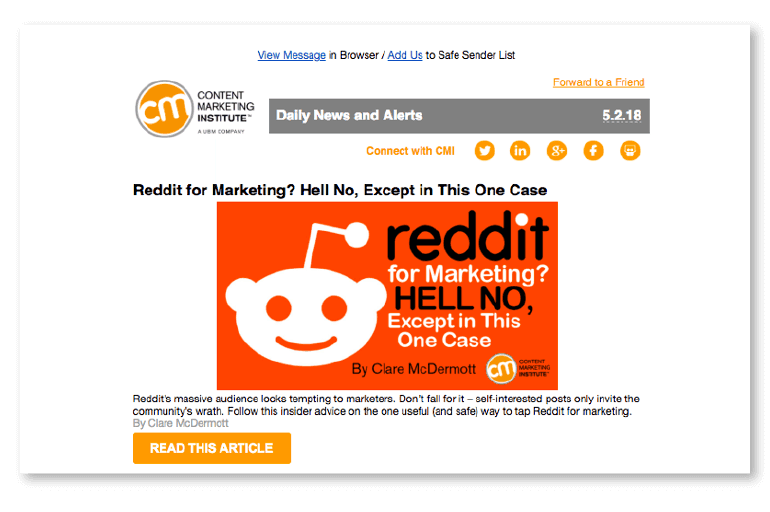 Head here to find a free code snippet you can use to drop a link like this in your email.
Head here to find a free code snippet you can use to drop a link like this in your email.
Make sure your emails get read! Learn all about whitelisting (and get 39 more great #email #marketing tips) here:
Click To Tweet30. Create Unique Email List Segments
The subscribers on your email list may have unique interests or different backgrounds. Sending the same messages to different groups of people might not always get similar results from each one. For example, if you run an auto parts ecommerce site, customers interested in Honda Civic accessories might not be interested in information about pickup trucks. How could a marketer in this situation keep both groups equally engaged? By segmenting their email list based on interests. Here’s how to get started using four different email service providers (each of which integrate with CoSchedule):Use list segmentation to make sure the right emails get to the right people
Click To Tweet10 Email List Building Tips
Without an email list, you’ll have no one to market toward. Use these 10 tips to build up your list and get more leads into the funnel.31. Create Valuable Gated Content Upgrades
Content upgrades are downloadable freebies gated behind an email opt-in form. To get these configured on your blog, website, or landing pages, you may need to get some developer help. But, once you’re ready to roll, here are some great ideas for content upgrades you can try:- Templates.
- eBooks.
- PDF guides.
- Research reports.
- Slide presentations.
- White papers.
- Case studies.
In the struggle to build an email list, content upgrades are your secret weapon.
Click To Tweet32. Include a Sticky CTA on Your Website
Here’s an example from the CoSchedule Blog: If you don’t have the capability to set this up yourself, work with a developer to add an email signup CTA somewhere on your blog or website homepage.
If you don’t have the capability to set this up yourself, work with a developer to add an email signup CTA somewhere on your blog or website homepage.
Use a CTA on your website to drive more #email signups
Click To Tweet33. Mention Subscriber Count to Leverage Social Proof
Another note to make your sticky CTAs more effective: include some social proof. Mentioning your subscriber count (once you have some subscribers) shows potential leads that you’re offering something of value.Leverage social proof by mentioning your subscriber count in your email signup call-to-action:
Click To Tweet34. Include a Signup Link in Personal Emails
If you email folks around your industry with your own work email account, drop a link in your signature to get your company’s email newsletters, too.If you email folks around your industry with your own work email account, drop a link in your signature to get your company’s email newsletters, too.
Click To Tweet35. Launch a Contest (With an Email Opt-In Form)
Contests and giveaways are a great way to gather email signups. You can do this in one of two ways:- With a physical entry form (for brick-and-mortar stores).
- An online content with a signup landing page.
36. Run a List-Building Social Media Campaign
If people are following you on social media, they’re obviously interested in your brand. So, why not get them onto your email list? Run a creative social campaign directing to your email signup page. CoSchedule customers can easily create cross-channel social campaigns:Create a social media campaign promoting your #email newsletter to get more sign-ups
Click To Tweet37. Optimize Your Email Opt-In Confirmation Process
If you use a single opt-in process, email subscribers will be added to your list as soon as they complete a form. However, if you use a double opt-in process, subscribers will need to click a confirmation link on an email they’ll receive. The second option helps cut down on junk signups (if someone is going to bother to click the confirmation link, you know they really want to be on your list). But, if the confirmation email goes into a SPAM folder, you could miss out on subscribers. Follow your email service provider’s guidelines on using double opt-in processes effectively:Use a double opt-in process to improve lead quality on your email list
Click To Tweet38. Use Wistia’s Turnstile to Turn Video Viewers Into Email Subscribers
If you use Wistia for video hosting, don’t overlook using Turnstile to add email opt-in forms to your videos. Find a video in your library and go to Timeline Actions: Then, click add Turnstile:
Then, click add Turnstile:
 You can then configure your video so viewers need to enter an email address to watch.
You can then configure your video so viewers need to enter an email address to watch.
Use Turnstile in @wistia to turn video viewers into email subscribers
Click To Tweet39. Try Exit Intent Pop-ups
Once someone has spent some time on your site, make sure you don’t lose them after they leave. Exit intent pop-ups make it easy to capture email signups when people start to move their cursor to leave your site: Here are some exit intent popup examples created with OptinMonster.
Here are some exit intent popup examples created with OptinMonster.
Get more email signups with exit intent popups
Click To Tweet40. Add an Email Signup Link to Your Website Footer
CoSchedule’s Head of Demand Generation, Nathan Ellering, says you can expect a footer link to contribute around 1% to your overall list growth. But, they’re also extremely easy to add, and every little bit helps. Ask your developer if they can throw in a footer link to your email signup page.Add an email signup link to your website footer to make it easily accessible all across your site
Click To Tweet

